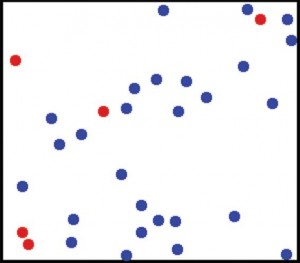In recent years, improper use of dust formulations has resulted in a significant increase in litigation. Are your techs properly trained in this technique?

Brownian motion is the random motion of particles suspended in a liquid or gas resulting from collisions with the quick atoms or molecules in the liquid or gas.
One statement regularly heard from dusting experts and regulatory officials in dust application lawsuit claims is “If the consumer can see the dust, you used too much!”
Some disagree, but when you have a number of credible experts testifying this is true, it complicates your defense.
Case in point
After a condo was treated for fleas, a state inspector was called in because the resident decided too much dust was used. The state inspector reported this as factual, and the resident moved out of the condo for six months.
The unit had to be cleaned three times, but we weren’t informed until the third treatment. Needless to say, the resident was very particular about residue of any kind. The bottom line is this claimant said the dust caused property damage and bodily injury.
But here’s the kicker: There were two other condos, both of which were treated with dust, resulting in the same complaints. This time, we were able to get in front of the situation before it spun out of control. Even though dust was visible in isolated areas, swab and air samples came back with normal results. Therefore, there was no ground for a legitimate claim. The condo that had to be treated three times per the resident’s demands was in the same shape. However, because we weren’t involved in the situation until later in the process, the tenant’s claim exceeded $100,000, while the other two units stand at $0.
On the claims side, it’s easy: If you know or retain an insurance or litigation professional who is familiar with these types of exposures, give him or her a call. It could make a significant difference in the outcome.
Customer: not always right
Dust formulations, when applied per label directions, are effective in the reduction and elimination of pest pressures. However, nowhere on a dust insecticide label will you ever find “apply per resident’s demands” or “treat if you feel like it.”
While following the directives of the product label, you must be aware of the hidden structural components that may carry a dust formulation from region A to region B. If you apply the product here, where will it go?
A dust formulation particle can be as tiny as 0.4 µm (a micrometer, or micron, is one-millionth of a meter). If one throws a little Brownian motion or physics into the mix, dusts can be either very effective tools or very expensive claims.
Brownian motion, or pedesis (Greek meaning “leaping”), is the random motion of particles suspended in a liquid or gas resulting from collisions with the quick atoms or molecules in the liquid or gas.
If particles subject to Brownian motion are present in a given medium, and there is no preferred direction for random oscillations, then over a period of time, the particles will tend to be spread evenly throughout the medium. In simpler terms, if A and B are two adjacent regions and, at the time of treatment, A contains twice as many particles as B, then at that instant the probability of a particle leaving A to enter B is twice as great as the probability that a particle will leave B to enter A. The physical process in which a substance tends to spread steadily from regions of high concentration to regions of lower concentration is known as diffusion.
Verifiable training
Now that you are thoroughly enlightened (or confused) on dust particle movement, realize that the bottom line in avoiding claims is to read, understand and follow the label. Within their directions, product labels incorporate and balance all dust formulation characteristics.
Whether in the office or in the field, facilitated training of applicators by licensees or vendors through instructional, hands-on dust applications must be completed and constantly updated. Most importantly, attendees must sign the training sheet for verification. No documentation, and it’s like it never happened.
Plaintiffs’ attorneys are subpoenaing training records and questioning if attendees are not documented or signed-in for verification. We can still defend if it’s not verified, but it does not often sit as well with a jury. Remember, an ounce of prevention means you can stay out of the courtroom — and continue on with your successful, ethical business.
Dr. Mitchell, D.O., Ph.D., M.P.H., B.C.E., a board-certified physician and entomologist, is PMP’s Technical Editor. He can be reached at docmitchell@northcoastmedia.net or 515-333-8923.
Andy McGinty is LIPCA Insurance EVP/COO.
For more on the duo’s “dusting equipment basics,” please visit PMP’s new blog at PestTalk
Leave A Comment